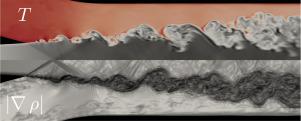Analysis of entrainment and mixing in a supersonic air ejector using Large-Eddy Simulation
IF 2.6
3区 工程技术
Q2 ENGINEERING, MECHANICAL
International Journal of Heat and Fluid Flow
Pub Date : 2025-07-26
DOI:10.1016/j.ijheatfluidflow.2025.109978
引用次数: 0
Abstract
The interest towards supersonic ejectors as replacement for compressors in various industrial applications has grown over the last decade. In contrast with the simplicity of their working principle, the turbulent phenomena responsible for the entrainment and mixing are still not fully understood nor well captured by numerical simulations. Indeed, mostly Reynolds-Averaged Navier–Stokes (RANS) simulations have been performed up to now, where the unsteady phenomena responsible for the entrainment are solely modeled using an effective turbulent viscosity, and that also needs calibration. This work aims at providing the tools to improve the understanding and design of those devices by analyzing the instantaneous and averaged fields from a Large-Eddy Simulation (LES) of a supersonic air ejector. First, the structure of the mixing layers is analyzed, showing a very early transition to turbulence in the shear layers and the necessity to properly capture the associated fluctuations. The impact of turbulence injection in the primary flow is also discussed. Then, the post-processing tools, using total exergy fluxes, are presented. The exergy fluxes between the streams in the mixing duct are computed, and are compared to their incomplete counterpart obtained using RANS simulation results. The observed discrepancies are shown to be due to the large differences in the turbulent shear stress and turbulent heat flux through the shear layer between the RANS and LES results. A new criterion to measure the completion of the mixing between the flows is introduced thanks to a novel decomposition of the total exergy flux. Finally, the complete mixing of both streams, as newly defined, is shown not to be a sufficient condition to find the optimum performance of the ejector, e.g. a maximum compression at the maximum flow rate of the secondary stream. This optimum is found to be much more dependent on the balance between shear stress between streams and wall-friction.

超声速空气引射器内夹带与混合的大涡模拟分析
在过去的十年里,人们对超音速喷射器作为压缩机替代品的兴趣在各种工业应用中不断增长。与它们工作原理的简单性相反,导致夹带和混合的湍流现象仍然没有被完全理解,也没有被数值模拟很好地捕捉到。事实上,到目前为止,大多数的reynolds - average Navier-Stokes (RANS)模拟都是通过有效的湍流粘度来模拟导致夹带的非定常现象,这也需要校准。本工作旨在通过分析超音速空气引射器的大涡模拟(LES)的瞬时场和平均场,为提高对这些装置的理解和设计提供工具。首先,对混合层的结构进行了分析,表明剪切层很早就转变为湍流,并且有必要适当地捕捉相关的波动。文中还讨论了湍流注入对一次流动的影响。然后,给出了利用总火用通量的后处理工具。计算了混合管内各流之间的火用通量,并与RANS模拟结果的不完全对应值进行了比较。观测到的差异是由于RANS和LES结果在通过剪切层的湍流剪切应力和湍流热通量方面存在很大差异。由于采用了一种新的火用总通量分解方法,引入了一种新的衡量流间混合完成程度的判据。最后,新定义的两流完全混合并不是喷射器最佳性能的充分条件,例如在二次流最大流速下的最大压缩。这个最优值更多地依赖于流和壁面摩擦之间的剪应力平衡。
本文章由计算机程序翻译,如有差异,请以英文原文为准。
求助全文
约1分钟内获得全文
求助全文
来源期刊

International Journal of Heat and Fluid Flow
工程技术-工程:机械
CiteScore
5.00
自引率
7.70%
发文量
131
审稿时长
33 days
期刊介绍:
The International Journal of Heat and Fluid Flow welcomes high-quality original contributions on experimental, computational, and physical aspects of convective heat transfer and fluid dynamics relevant to engineering or the environment, including multiphase and microscale flows.
Papers reporting the application of these disciplines to design and development, with emphasis on new technological fields, are also welcomed. Some of these new fields include microscale electronic and mechanical systems; medical and biological systems; and thermal and flow control in both the internal and external environment.
 求助内容:
求助内容: 应助结果提醒方式:
应助结果提醒方式:


